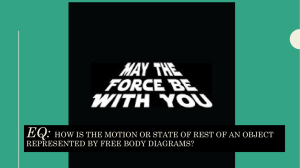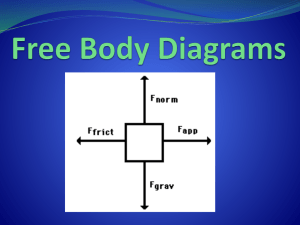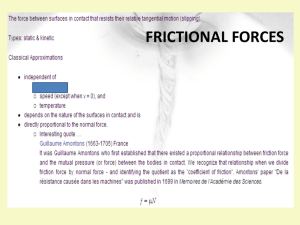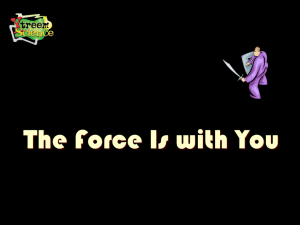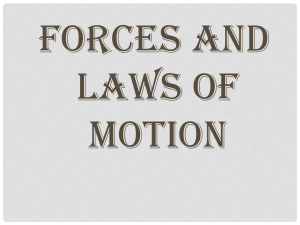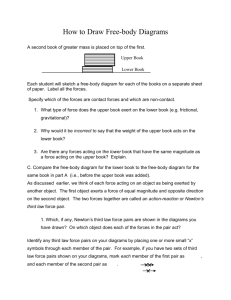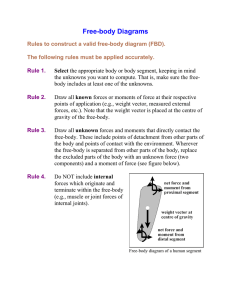Forces and Free Body Diagrams
advertisement
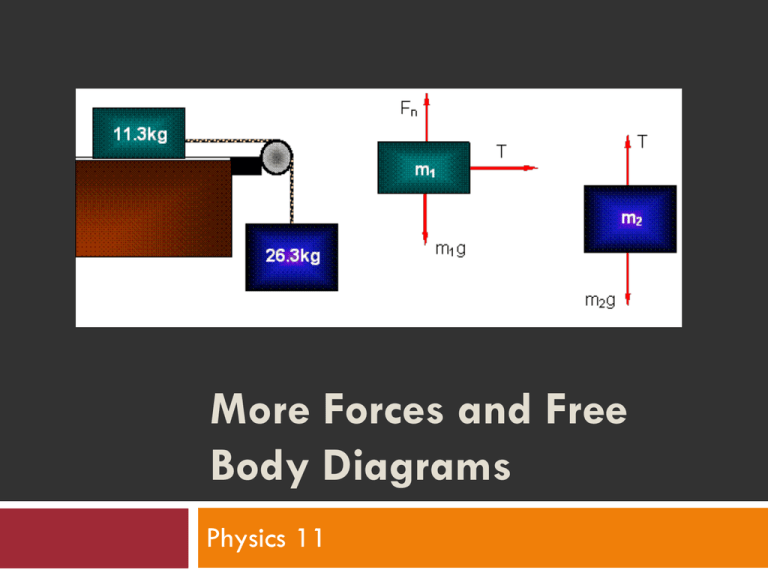
More Forces and Free Body Diagrams Physics 11 More forces: Meet the Forces Handout! Add symbols Add Applied force: Usually FBD) a push or pull (which generally look the same on a Free-body diagrams: Free-body diagrams are used to show the relative magnitude and direction of all forces acting on an object. Free-body diagrams (FBDs)… Represent all forces acting on one object and only the forces on the object. The forces that this object exerts on other objects are not included. If there is more then one object involved, each object needs its own FBD. Object drawn as a box or dot, forces indicated with arrows This diagram shows four forces acting upon an object. There aren’t always four forces. For example, there could be one, two, or three forces. Create a free body diagram (FBD) for each of the following situations. Draw a FBD of the gorilla: N W Sitting Gorilla Free Body Diagram of the Sitting Gorilla (The box represents the gorilla, W = weight of the gorilla, N = Normal force) Draw a FBD of the wooden swing: T1 T2 W Parrot on wooden swing hung by ropes Free Body Diagram of the wooden swing (The box represents the wooden swing, W = weight of the swing and the parrot, T represents the ropes that are in tension supporting the weight) Draw a FBD of bucket the bungee jumper leaped from: T W Bungee jumping from crane Free Body Diagram of the bucket (T represents the tensile force of the cable the bucket is suspended from, and W is the weight of the diver and the bucket) Problem 1 A book is at rest on a table top. Diagram the forces acting on the book. Problem 1 In this diagram, there are normal and gravitational forces on the book. Problem 2 An egg is free-falling from a nest in a tree. Neglect air resistance. Draw a free-body diagram showing the forces involved. Gravity is the only force acting on the egg as it falls. Problem 3 A flying squirrel is gliding (no wing flaps) from a tree to the ground at constant velocity. Consider air resistance. A free body diagram for this situation looks like… Gravity pulls down on the squirrel while air resistance keeps the squirrel in the air for a while. Problem 4 A rightward force is applied to a book in order to move it across a desk. Consider frictional forces. Neglect air resistance. Construct a free-body diagram. Let’s see what this one looks like. Note the applied force arrow pointing to the right. Notice how friction force points in the opposite direction. Finally, there is still gravity and normal forces involved. Problem 5 A skydiver is descending with a constant velocity. Consider air resistance. Draw a free-body diagram. Gravity pulls down on the skydiver, while air resistance pushes up as she falls. Problem 6 A football is moving upwards toward its peak after having been booted by the punter (ignore air resistance). Draw a free-body diagram. The force of gravity is the only force described. It is not a windy day (no air resistance). Problem 7 A car runs out of gas and is coasting down a hill. Draw on board with incline. Even though the car is coasting down the hill, there is still the dragging friction of the road (left pointing arrow) as well as gravity and normal forces. Practice: Pg 148 #12-15 Free Body Diagram Sheet
